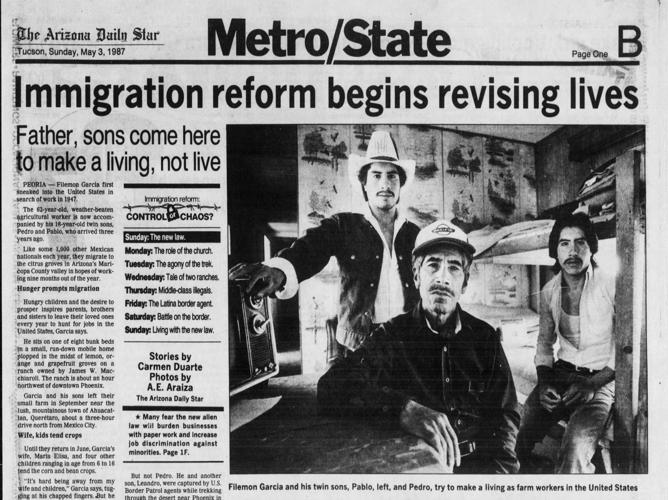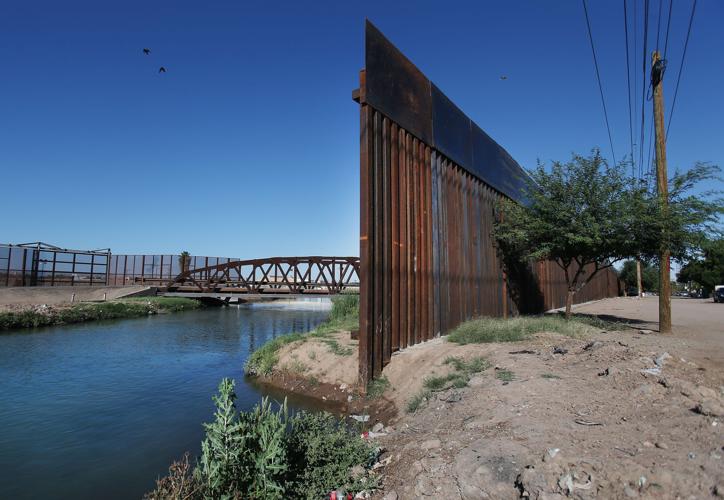The executive order on immigration signed by President Donald Trump on Jan. 25 is the most recent entry in a debate that stretches back to the founding of the United States.
The purpose of the "Border Security and Immigration Enforcement Improvements" order is to strengthen border security and crack down on millions of people who crossed the border illegally or overstayed their visas, two goals that spawned thousands of bills in Congress since the 1970s and more than 60 bills so far in the 2017-18 Congressional session.
Trump cited three laws as the source of presidential authority on border and immigration issues:
The Immigration and Nationality Act of 1952, the Illegal Immigration Reform and Immigrant Responsibility Act of 1996, and the Secure Fence Act of 2006.
What did those laws do?
The timeline below shows the laws that laid the foundation for the executive order and the policy debate that continues in Congress.
Immigration and Nationality Act of 1952
Vote: Passed Senate and House. Vetoed by President Harry S Truman. Veto overridden in Senate, 57-26, and in the House, 278-113.
Main provisions:
- Ended race-based restrictions on immigration
- Kept national-origin quotas from the 1920s that favored Northern and Western Europe
- Allowed deportation for subversive activities
- Allowed legal status for skilled immigrants and relatives of U.S. citizens
Immigration and Nationality Act of 1965
Vote: Introduced by Rep. Emanuel Celler (D-N.Y.). Passed Senate, 76-18; passed House, 320-70. Signed by President Lyndon B. Johnson on Nov. 3, 1965.
Main provisions:
- Eliminated national-origin quotas
- Raised total annual visas from 150,000 to 290,000, with preference for wanted skills and family members of U.S. citizens
- 170,000 visas set aside for residents of the Eastern Hemisphere and 120,000 visas for residents of the Western Hemisphere
- No restrictions on how many immediate family members of U.S. citizens could receive visas
Immigration Reform and Control Act of 1986
Vote: Introduced by Sen. Alan K. Simpson (R-Wyo.). Passed Senate, 63-24; passed House, 238-173. Signed by President Ronald Reagan on Nov. 6, 1986.
Main provisions:
- Legal status for 2.7 million undocumented immigrants who lived in the United States continuously since 1982 and certain agricultural workers
- Penalized employers who knowingly hire undocumented workers
- Raised Border Patrol staffing by 50 percent
Vote: Introduced by Sen. Edward Kennedy (D-Mass.). Passed Senate, 81-17; passed House 264-118. Signed by President George Bush on Nov. 29, 1990.
Main provisions:
- Increased annual number of immigrants admitted into the United States by 40 percent, to 700,000, and created new family and work-related visas
- Lottery system for immigrants from countries where residents had received few visas
- Created temporary protected status for people fleeing environmental disasters or armed conflict
- Expanded crimes included in a 1988 law that make a person deportable
Illegal Immigration Reform and Immigrant Responsibility Act of 1996
Vote: Senate bill passed 72-27; similar House bill passed, 278-126. Conference report approved on Sept. 30, 1996 and signed by President Bill Clinton.
Main provisions:
- Added 5,000 new Border Patrol agents and required the construction of a 14-mile border fence near San Diego
- Created 287(g) program to allow local police to act as immigration agents (cited in Trump's order)
- Prohibited in-state tuition for undocumented immigrants
- Banned immigrants who lived in the country illegally from returning for three or 10 years (see the Divided by Law series by the Star and Arizona Public Media on a Tucson family separated by the ban)
- Expands crime that make a person deportable
REAL ID Act of 2005
Vote: Introduced by Rep. James F. Sensenbrenner (R-Wis). Passed House, 261-161. Passed Senate unanimously as part of military spending bill.
Main provisions:
- Increased security measures for identification cards and directed states to comply with federal ID standards
- Allowed the Department of Homeland Security to waive any law that impeded construction of border barriers
Comprehensive Immigration Reform Act of 2006 (S. 2611)
Vote: Introduced by Sen. Arlen Specter (R-Pa.). Passed Senate, 62-36. Died in House.
Main proposals:
- 14,000 more Border Patrol agents
- 370 miles of border fence
- Require employers verify work visas
- Grant legal status to long-term undocumented immigrants
- Expand guest-worker visas
Vote: Introduced by Rep. Peter King (R-N.Y.). Passed Senate 80-19; passed House, 283-138. Signed by President George W. Bush on Oct. 26, 2006.
Main provisions:
- $1.2 billion for increased border security and 700 miles of double-layered border fence
- Authorized more Border Patrol checkpoints and surveillance equipment, including drones
Secure Borders, Economic Opportunity and Immigration Reform Act of 2007 (S. 1348)
Vote: Introduced by Sen. Harry Reid (D-Nev.) on May 9, 2007. Died after yay-nay vote, 45-50.
Main proposals:
- Add as many as 20,000 Border Patrol agents
- Develop a temporary guest-worker program
- Declare English as the national language
- 370 miles of triple-layered fence, as well as radar, camera towers, and other surveillance equipment
Border Security, Economic Opportunity, and Immigration Modernization Act of 2013 (S. 744)
Vote: Introduced by "Gang of Eight" congressional leaders. Passed Senate, 68-32. Died in House.
Main proposals:
- Path to legal status for undocumented immigrants
- 17,000 more Border Patrol agents
- Add high-tech surveillance equipment at the border
- Require use of E-verify by employers
- Expand guest-worker programs
Research by Curt Prendergast and Nate Airulla
Sources: Library of Congress, Migration Policy Institute, U.S. Citizenship and Immigration Services, Center for Immigration Studies, U.S. Department of State, Arizona Daily Star archives, media reports





